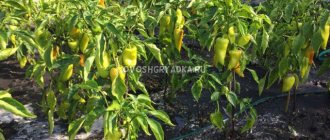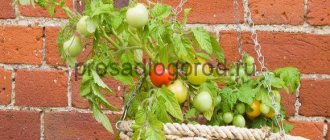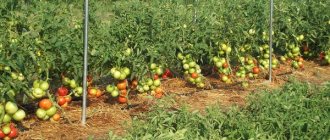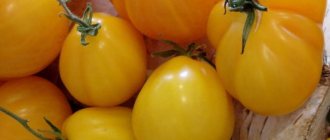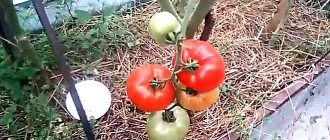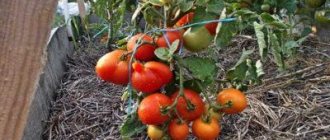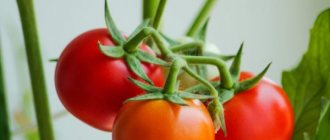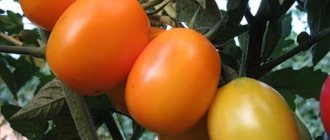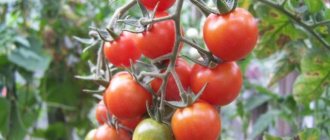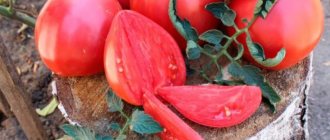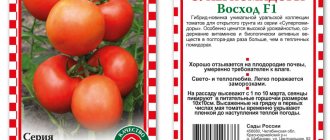Forming tomatoes, or pinching, as the technique is more often called by people, is the most important agrotechnical technique, without which it is almost impossible to grow a good harvest. Only certain varieties of super early tomatoes do without pinching.
Even the absence of fertilizing may have less impact on yield than uncontrolled growth of the bush. But even when pinching, you cannot do without knowledge of the characteristics of the variety, methods, formation schemes and certain rules.
Why form a tomato bush?
The main part of tomato varieties has the physiological ability to form lateral shoots in almost every axil, on which, in turn, new ones grow. The growth and expansion of the bush occurs in geometric progression.
Such growth in a short time turns the bush into a pile of green mass. While there may be a lot of flowers on it, the ovaries are unlikely to be numerous. In order for full-fledged fruit clusters to form, the plant will need a lot of nutrition and light.
The plant does not have enough strength for the simultaneous intensive growth of green mass, development and ripening of fruits. An agrotechnical technique that significantly improves the condition of the bush and increases productivity is formation. This is an artificial regulation of the number of shoots to create favorable conditions for fruiting of the bush.
Advantages and disadvantages of forming tomatoes into 2 stems
Quite often, two stems are left for fruiting, which become almost equivalent, like a mirror image of each other. Medium-sized indeterminate and almost all determinate varieties can be formed into two stems. The exception is standard varieties that do not produce side shoots. This formation allows:
- get an early harvest from the first clusters;
- increase the number of fruit clusters in varieties with limited growth;
- effectively use the area of low protective structures.
Among the disadvantages:
- Each of the shoots needs a garter;
- the danger of stems breaking under the weight of the crop at the site where the second shoot grows;
- shade increases with double the number of leaves.
General rules and scheme for forming a bush with two stems
When to start
There are two common methods for growing two stems with one root system:
- The most common method is in which the first pinching is carried out 10-14 days after planting the seedlings in the ground.
Plants planted in the ground quickly acclimatize, and the seedling will have its first cluster of flowers. Active growth of shoots begins. If you are late in planting the seedlings, the first cluster may appear already in the pot, then pinching begins immediately after the seedlings have taken root.
A healthy stepson is left in the leaf axil below the flower raceme and cared for in the same way as the main stem. Over time, both stems will become equal, and new shoots will appear in the axils of the leaves that need to be removed.
- The second method is to form a bush at the stage of seedling production.
It is called the early pinching method. The top of the seedling is pinched after the second true leaf, then equivalent shoots will appear in the axil of the first and second leaves, from which two trunks will develop. It is believed that this method is less damaging to the plant. On the other hand, at an early stage it is difficult to predict whether these shoots will be healthy and of high quality.
How to stepchild
In order not to harm the plant, pinching work must be carried out in compliance with certain rules:
- Plants must be dry, without dew, so that moisture does not introduce infection into the wounds. In this regard, the plants are not fed on the eve of pinching.
- The work is carried out in dry weather at moderate air temperatures.
- The best time for pinching is in the morning, when the shoots are juicier and break easily.
- The optimal shoot size for removal is up to 5 cm. Overgrown shoots overload the plants, and when they are removed, the stem may be injured. Such shoots need to be cut out with a knife.
- The main method of stepsoning is breaking out the stepson manually. To do this, take it to the side, holding it with your fingers, and press it down with a little effort. If the plant is not withered, the stepson will break off very easily.
- To prevent a new one from growing in the leaf axil after removing one shoot, it is necessary to leave a small stump when breaking off, which will give the plant a signal that the place is occupied.
Attention! Plants that show signs of disease are pruned last, disinfecting the knife and hands after each bush.
To prevent shoots from overgrowing, bushes must be inspected weekly.
When and how to pinch
The next step in forming a bush is pinching the growth point. If the bush was formed into two stems from which all shoots were removed, then there are two such points.
Some varieties with limited growth may not need to be topped. It all depends on the timing of the growing season, the development of the plant, the place where it is grown and weather conditions.
Pinching the growing point helps mobilize the plant to set fruit and ripen it. The growth point is not pinched immediately above the flower brush, but 2-3 leaves after it. This will improve the plant's photosynthesis.
Important! Pinching of the growing point is carried out after the flowers of the last inflorescence open.
Removing leaves
In parallel with breaking off the stepsons, the leaves below the fruit clusters are removed. No more than 2 healthy leaves are removed from each stem at a time. Diseased leaves are removed first.
Stepping technique
Stepchildren must be removed by hand. When using a tool, there is a risk of transmitting infection from bush to bush. Prepare thin rubber gloves and a weak solution of potassium permanganate in which you will rinse your hands before moving on to the next plant. Start pinching with the strongest and healthiest plants. Leave those that raise doubts for last, or better yet, for another day. Plan the stepsoning procedure in the morning hours of a fine day. After watering or fertilizing, you cannot plant tomatoes; wait 2-3 days, during which time the plant actively absorbs water and nutrients.
In this video you can see how to properly plant tomatoes:
Grab the stepson with your fingers from above and pinch it. You can powder the place where the stepson breaks with ash or crushed coal. Throw the removed sprout under the bush; as it decomposes, it will fertilize the soil.
When removing the stepson, do not pull it down; together with the stepson, you can tear the skin off the stem. In addition to stress from injury, an open wound on a bush can become infected. After pinching, you can water by the evening of the next day.
Features of the formation of a bush with 2 stems
In the greenhouse
Tall tomatoes, both determinate and with limited growth, are often planted in the greenhouse. They are formed into 1 or 2 stems. The principles of pinching for organizing two stems are general. When planting, you need to take into account that you need twice as much food and space for two stems and they need to be tied up separately. In order for all the clusters to set fruit and ripen during the growing season, you need to pinch the growth point in a timely manner.
In the open ground
Preference is given to low-growing and medium-growing tomato varieties. In a short growing season, you need to get the maximum yield, so forming two or three stems is an effective technique. At the same time, in low-growing varieties the top is not pinched, but in medium-growing varieties the decision about pinching is made depending on the condition of the plant and weather conditions.
general information
Tomatoes are a heat-loving vegetable crop, but summer does not always bring favorable weather. Gardeners are increasingly beginning to grow vegetables in polycarbonate greenhouses. Under cover, plants are not afraid of temperature fluctuations, precipitation, wind and other unfavorable factors.
Almost all types of tomatoes require pinching, which means cutting off the side branches. The exception is standard species. This is a variety of the determinate group of tomatoes. Growing standard tomatoes is very easy and simple. They do not require the removal of side branches, the formation of a central trunk and tying to a support.
Standard-type tomato bushes have a strong, powerful stem that stretches up to 60 cm. 4 fruiting clusters are formed on the stem.
Tall varieties of tomatoes without the formation of a main stem begin to branch in different directions, forming many flowers that do not have time to grow into fruits. Therefore, the formation of tomatoes in a greenhouse is considered a mandatory procedure. Cutting off unnecessary, weak inflorescences will lead to the fact that all efforts will be directed to the development of a full-fledged harvest.
Stepping is carried out for three main reasons:
- unlimited growth of the bush leads to the development of numerous lateral flowering branches and ovaries, which require more nutritional components and energy for excess greenery;
- a large number of leaves leads to insufficient penetration of sunlight and air to various parts of the plant;
- a formed tomato bush produces a high-quality and plentiful harvest.
To carry out the procedure correctly, you need to clearly distinguish an ordinary leaf from a stepson. Stepchildren grow between the main stem and leaves. First, the leaf itself appears, and above, after some time, a stepson begins to form. It turns out that they grow from one point. Tear off the top sprout without touching the bottom one.
How to form a bush is up to everyone to decide for themselves. For tomatoes in open ground, it is permissible to have two stems, but in a polycarbonate greenhouse they can be grown with one stem. This is suitable for tall types of tomatoes. Determinate varieties of tomatoes in a greenhouse usually have two main stems, while tomatoes in open ground can have three stems.
If the stem is formed correctly, it will slow down the growth of the vegetable crop and increase the amount of harvest. Growing and shaping tomato bushes in a greenhouse consists of pinching, pinching and other manipulations.
How to properly form a trunk
- In determinate tomatoes
This is a type of bush that produces a flower cluster early (after 3-4 leaves). After another 2-3 leaves, another one appears. The distance between the following brushes is reduced. After several brushes (from 2 to 8), the growth of the plant ends (determines).
In other words, instead of a growing shoot, the last flower cluster is laid. If you remove all the shoots from the main stem, the growing season will end with only these brushes.
At the same time, a healthy plant with a developed root system is capable of more. To increase the potential, at the beginning of the growing season, the first healthy shoot is left, from which the second stem grows. It has the same functions as the main one. Caring for it is the same.
- In super-determinate or super-early tomatoes
You can prolong fruiting by leaving not the lower stepson, but the last one, located below the last brush. Other lateral processes are removed. This will give the plant the opportunity to plant 1-2 more flower clusters on this shoot. Some super-early varieties (standard) do not require formation, since they practically do not form lateral branches.
Common mistakes of beginner gardeners + video
At first glance, both pinching and pinching tomatoes are not particularly difficult. However, the lack of sufficient experience can lead to certain mistakes that will negatively affect the development of plants and ultimately the harvest. It will be easier to master these operations if you first watch a video of how professionals form tomatoes in a greenhouse and what equipment and materials they use for this.
Video: Forming tomatoes in a greenhouse according to all the rules
It happens that the growth of the top of the main stem stops after the formation of a flower cluster. Therefore, you should not rush to remove the first stepson - it will be able to replace the main stem if it stops growing. Perform pinching only after making sure that the main shoot has continued its development after the appearance of the first cluster.
If you miss time, the lateral processes may develop well and it will be a pity to remove them. But this operation is necessary, even if there is a fear of damaging the bush. It is advisable to monitor the appearance of stepchildren and prevent their excessive growth.
Growing vegetables in a greenhouse is a fascinating process and a profitable activity. For lovers, this is the best way to diversify and enrich your winter diet with vitamins. For entrepreneurs it is a source of stable high income. And in both cases, an important success factor is the correct application of agricultural methods. If you have any questions, you can always contact specialists who will provide qualified information support and help you learn the necessary skills.
Recommendations for forming a bush
In order for a tomato bush to provide maximum returns, you need to choose a formation scheme that is most suitable for a particular variety and its growing conditions. To do this, you need to know exactly what variety you are growing and its physiological characteristics. Delaying the timing of pinching has a negative impact on the yield.
Forming tomato plants into 2 stems is a simple agrotechnical technique that allows you to grow a good harvest of early produce and rationally use the garden space.
